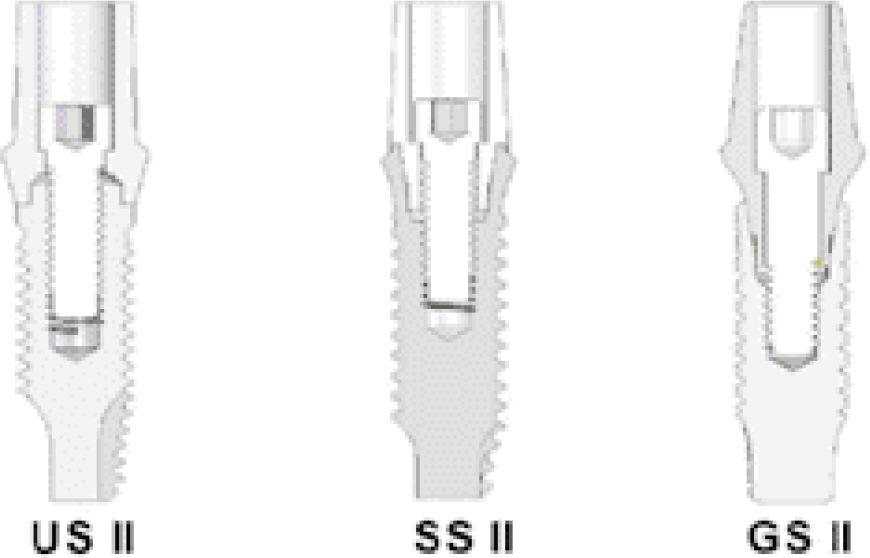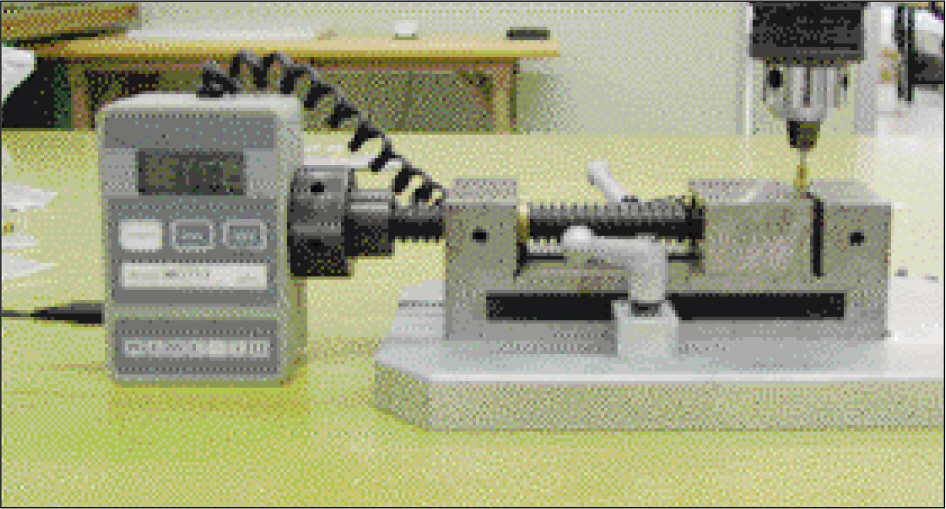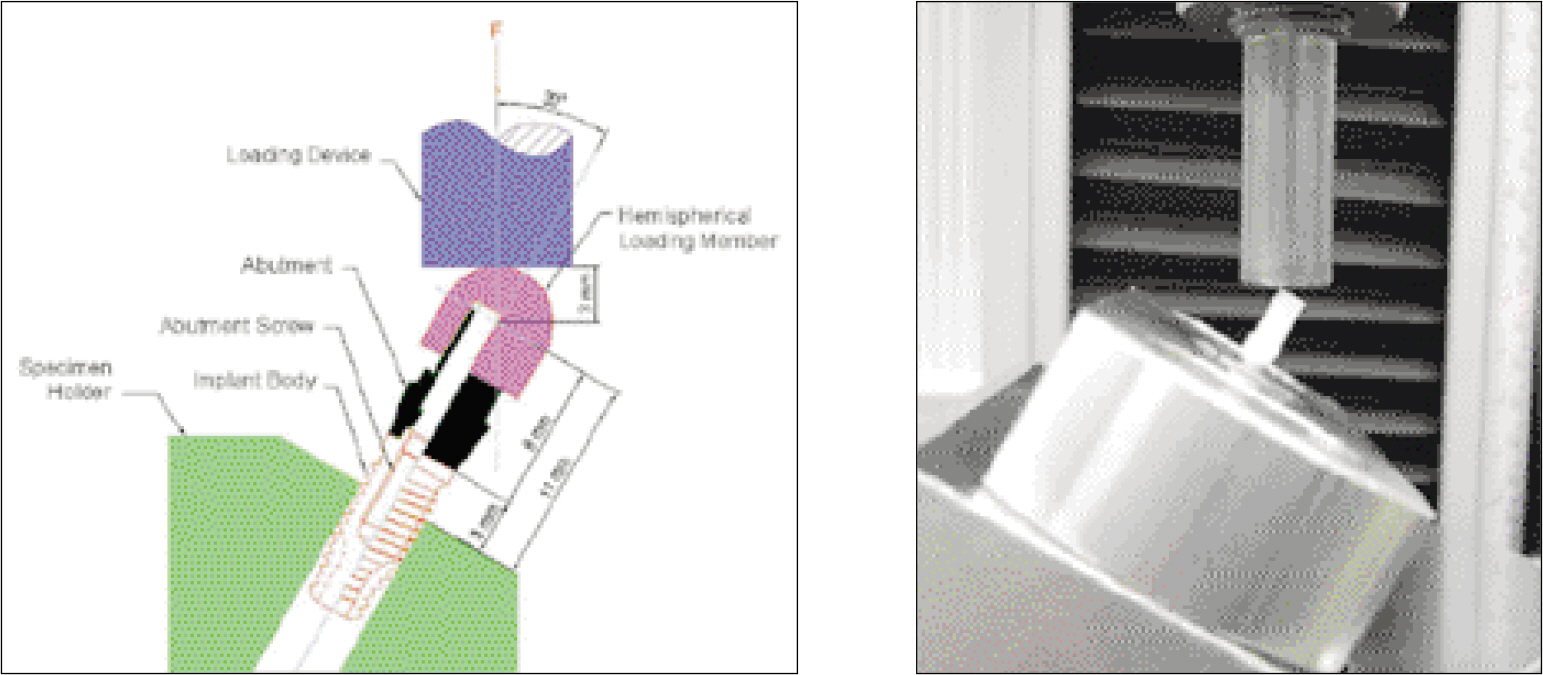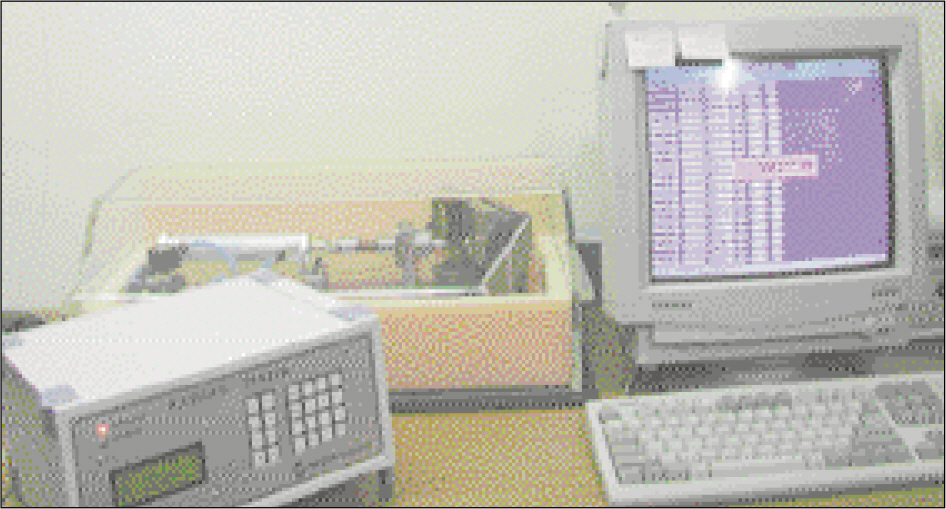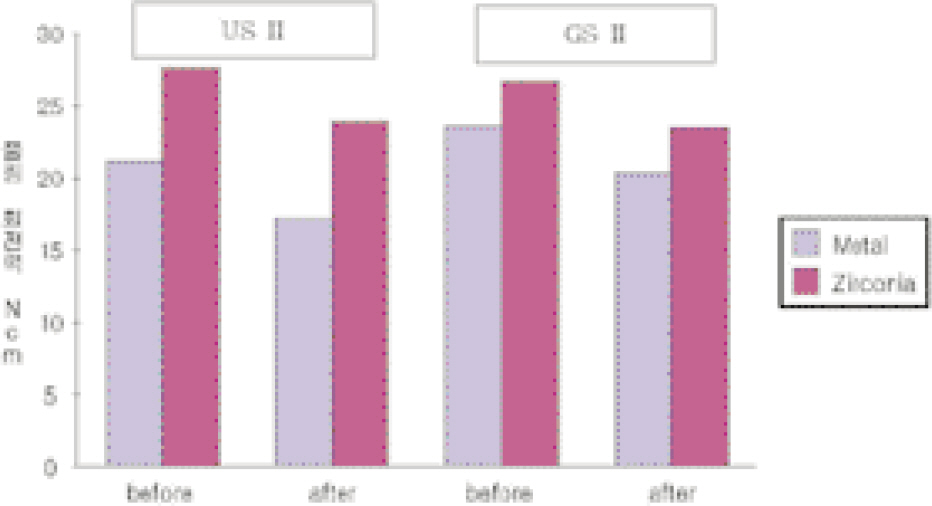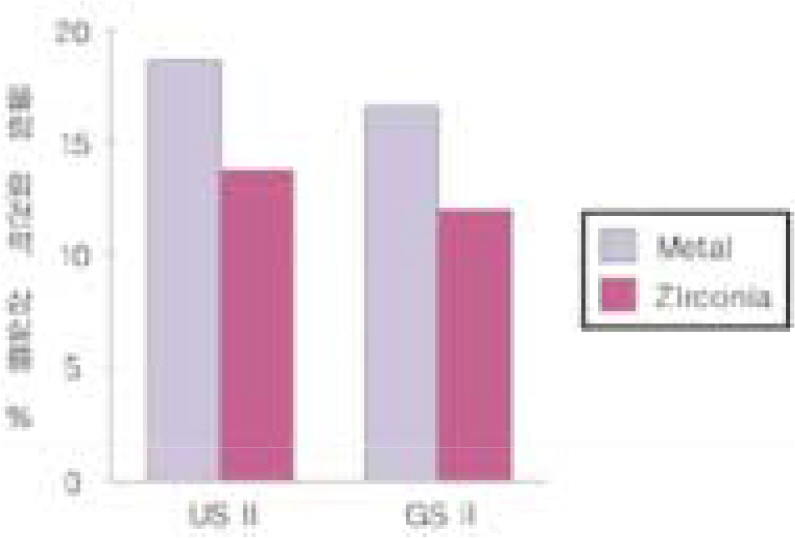J Korean Acad Prosthodont.
2009 Apr;47(2):164-173. 10.4047/jkap.2009.47.2.164.
Screw Joint Stability under Cyclic Loading of Zirconia Implant Abutments
- Affiliations
-
- 1Esthetic Restorative Dentistry, Korea University Graduate School of Clinical Dentistry, Korea University Institute for Clinical Dental Research, Korea. koprosth@unitel.co.kr
- KMID: 2195613
- DOI: http://doi.org/10.4047/jkap.2009.47.2.164
Abstract
- PURPOSE
The purpose of this study was to evaluate the effect of abutment material on screw-loosening before and after cyclic loading. Among the different materials of abutments, zirconia and metal abutment were used. MATERIAL AND METHODS:: Two types of implant systems: external butt joint (US II, Osstem Implant, Korea) and internal conical joint (GS II, Osstem Implant, Korea) were used. In each type, specimens were divided into two different kinds of abutments: zirconia and metal (n = 5). The implant was rigidly held in a special holding to device ensure fixation. Abutment was connected to 30 Ncm with digital torque gauge, and was retightened in 30 Ncm after 10 minutes. The initial removal torque values were measured. The same specimens were tightened in 30 Ncm again and held in the cycling loading simulator (Instron, USA) according to ISO/FPIS 1480. Cycling loading tests were performed at loads 10 to 250 N, for 1 million cycles, at 14 Hz, (by subjecting sinusoidal wave from 10 to 250 N at a frequency of 14 Hz for 1 million cycles,) and then postload removal torque values were evaluated. RESULTS: 1. In all samples, the removal values of abutment screw were lower than tightening torque values (30 Ncm), but the phenomenon of the screw loosening was not observed. 2. In both of the implant systems, initial and postload removal torque of zirconia abutment were significantly higher than those of metal abutment (P < .05). 3. In both of the implant systems, the difference in removal torque ratio between zirconia abutment and metal abutment was not significant (P > .05). 4. In metal abutments, the removal torque ratio of GS II system (internal conical joint system) was lower than that of US II system (external butt joint system) (P < .05). 5. In zirconia abutments, the difference in removal torque ratio between the two implant systems was not significant (P > .05). CONCLUSION: Zirconia abutment had a good screw joint stability in the condition of one million cycling loading.
Keyword
Figure
Reference
-
1.Bra � nemark PI. Osseointegration and its experimental background. J Prosthet Dent. 1983. 50:399–410.2.Rangert B., Jemt T., Jo ¨rneus L. Forces and moments on Branemark implants. Int J Oral Maxillofac Implants. 1989. 4:241–7.3.Binon P., Sutter F., Beaty K., Brunski J., Gulbransen H., Weiner R. The role of screws in implant systems. Int J Oral Maxillofac Implants. 1994. 9:48–63.4.Kallus T., Bessing C. Loose gold screws frequently occur in full-arch fixed prostheses supported by osseointegrated implants after 5 years. Int J Oral Maxillofac Implants. 1994. 9:169–78.5.Hemmings KW., Schmitt A., Zarb GA. Complications and maintenance requirements for fixed prostheses and over-dentures in the edentulous mandible: a 5-year report. Int J Oral Maxillofac Implants. 1994. 9:191–6.6.Zarb GA., Schmitt A. The longitudinal clinical effectiveness of osseointegrated dental implants: the Toronto study. Part III: Problems and complications encountered. J Prosthet Dent. 1990. 64:185–94.
Article7.Jemt T. Fixed implant-supported prostheses in the edentulous maxilla. A five-year follow-up report. Clin Oral Implants Res. 1994. 5:142–7.
Article8.Jemt T., Lekholm U. Implant treatment in edentulous maxillae: a 5-year follow-up report on patients with different degrees of jaw resorption. Int J Oral Maxillofac Implants. 1995. 10:303–11.9.Jemt T., Laney WR., Harris D., Henry PJ., Krogh PH Jr., Polizzi G., Zarb GA., Herrmann I. Osseointegrated implants for single tooth replacement: a 1-year report from a multicenter prospective study. Int J Oral Maxillofac Implants. 1991. 6:29–36.10.Naert I., Quirynen M., van Steenberghe D., Darius P. A six-year prosthodontic study of 509 consecutively inserted implants for the treatment of partial edentulism. J Prosthet Dent. 1992. 67:236–45.
Article11.Bickford JH. An introduction to the design and behavior of bolted joints. New York: Marcel Deckker;1981. p. 247–64.12.Cibirka RM., Nelson SK., Lang BR., Rueggeberg FA. Examination of the implant-abutment interface after fatigue testing. J Prosthet Dent. 2001. 85:268–75.
Article13.Gratton DG., Aquilino SA., Stanford CM. Micromotion and dynamic fatigue properties of the dental implant-abutment interface. J Prosthet Dent. 2001. 85:47–52.
Article14.Haack JE., Sakaguchi RL., Sun T., Coffey JP. Elongation and preload stress in dental implant abutment screws. Int J Oral Maxillofac Implants. 1995. 10:529–36.15.Faulkner MG., Wolfaardt JF., Chan A. Measuring abutment/implant joint integrity with the Periotest instrument. Int J Oral Maxillofac Implants. 1999. 14:681–8.16.Gross M., Abramovich I., Weiss EI. Microleakage at the abutment-implant interface of osseointegrated implants: a comparative study. Int J Oral Maxillofac Implants. 1999. 14:94–100.17.Yildirim M., Edelhoff D., Hanisch O., Spiekermann H. Ceramic abutments—a new era in achieving optimal esthetics in implant dentistry. Int J Periodontics Restorative Dent. 2000. 20:81–91.18.Piconi C., Maccauro G. Zirconia as a ceramic biomaterial. Biomaterials. 1999. 20:1–25.
Article19.Heydecke G., Sierraalta M., Razzoog ME. Evolution and use of aluminum oxide single-tooth implant abutments: a short review and presentation of two cases. Int J Prosthodont. 2002. 15:488–93.20.Andersson B., Taylor A., Lang BR., Scheller H., Sch?rer P., Sorensen JA., Tarnow D. Alumina ceramic implant abutments used for single-tooth replacement: a prospective 1-to 3-year multicenter study. Int J Prosthodont. 2001. 14:432–8.21.Cho HW., Dong JK., Jin TH., Oh SC., Lee HH., Lee JW. A study on the fracture strength of implant-supported restorations using milled ceramic abutments and all-ceramic crowns. Int J Prosthodont. 2002. 15:9–13.22.Andresson B. Implants for single-tooth replacement. A clinical and experimental study on the Branemark CeraOne system. Swed Dent J Suppl. 1995. 108:1–41.23.Yildirim M., Fischer H., Marx R., Edelhoff D. In vivo fracture resistance of implant-supported all-ceramic restorations. J Prosthet Dent. 2003. 90:325–31.24.Shin HM., Jeong CM., Jeon YC., Jeong HC., Eom TG. Influence of tightening torque on implant-abutment screw joint stability. [MS dissertation.]. Korea: Pusan National University;2007.25.Siamos G., Winkler S., Boberick KG. Relationship between implant preload and screw loosening on implant-supported prostheses. J Oral Implantol. 2002. 28:67–73.26.ISO/FDIS 14801 Dentistry - Fatigue test for endosseous dental implants. International Organization for Standardization. 2003. (E).27.Wiskott HW., Nicholls JI., Belser UC. Stress fatigue: basic principles and prosthodontic implications. Int J Prosthodont. 1995. 8:105–16.28.Prestipino V., Ingber A. Esthetic high-strength implant abutments. Part I. J Esthet Dent. 1993. 5:29–36.29.Prestipino V., Ingber A. Esthetic high-strength implant abutments. Part II. J Esthet Dent. 1993. 5:63–8.
Article30.Prestipino V., Ingber A. All-ceramic implant abutments: esthetic indications. J Esthet Dent. 1996. 8:255–62.
Article31.Scherrer SS., Kelly JR., Quinn GD., Xu K. Fracture toughness (KIc) of a dental porcelain determined by fractograph-ic analysis. Dent Mater. 1999. 15:342–8.
Article32.Glauser R., Sailer I., Wohlwend A., Studer S., Schibli M., Sche ′rer P. Experimental zirconia abutments for implant supported single-tooth restorations in esthetically demanding regions: 4-year results of a prospective clinical study. Int J Prosthodont. 2004. 17:285–90.33.Gehrke P., Dhom G., Brunner J., Wolf D., Degidi M., Piattelli A. Zirconium implant abutments: fracture strength and influence of cyclic loading on retaining-screw loosening. Quintessence Int. 2006. 37:19–26.34.Butz F., Heydecke G., Okutan M., Strub JR. Survival rate, fracture strength and failure mode of ceramic implant abutments after chewing simulation. J Oral Rehabil. 2005. 32:838–43.
Article35.Att W., Kurun S., Gerds T., Strub JR. Fracture resistance of single-tooth implant-supported all-ceramic restorations: an in vitro study. J Prosthet Dent. 2006. 95:111–6.36.Korioth TW., Cardoso AC., Versluis A. Effect of washers on reverse torque displacement of dental implant gold retaining screws. J Prosthet Dent. 1999. 82:312–6.
Article37.Mcglumphy EA. Keeping implant screws tight: the solution. J Dent Symp. 1993 Aug. 1:20–3.38.Adrian ED., Krantz WA., Ivanhoe JR., Turner KA. A silicone obturator for the access canal in an implant-retained fixed prosthesis. J Prosthet Dent. 1991. 65:597.
Article39.Kirkwood WF., Feng WW., Scott RG., Streit RD., Goldberg A. Mechanical properties and science of engineering materials. In: Blake A[ed]. Handbook of Mechanics, Materials, and Structures. London: Wiley;1985. p. 320–8.40.Leempoel PJ., Van' t Hof MA., de Haan AF. Survival studies of dental restorations: criteria, methods and analyses. J Oral Rehabil. 1989. 16:387–94.
Article41.Mericske-Stern R., Zarb GA. In vivo measurements of some functional aspects with mandibular fixed prostheses supported by implants. Clin Oral Implants Res. 1996. 7:153–61.42.Richter EJ. In vivo vertical forces on implants. Int J Oral Maxillofac Implants. 1995. 10:99–108.43.Carlsson GE., Haraldson T. Functional response in tissue-integrated prosthesis,. 4th ed.Quintessence Publ, co;1986. p. 74–78.44.Bates JF., Stafford GD., Harrison A. Masticatory function - a review of the literature. III. Masticatory performance and efficiency. J Oral Rehabil. 1976. 3:57–67.45.Richter EJ. In vivo vertical forces on implants. Int J Oral Maxillofac Implants. 1995. 10:99–108.46.Norton MR. Assessment of cold welding properties of the internal conical interface of two commercially available implant systems. J Prosthet Dent. 1999. 81:159–66.
Article47.Weiss EI., Kozak D., Gross MD. Effect of repeated closures on opening torque values in seven abutment-implant systems. J Prosthet Dent. 2000. 84:194–9.
Article48.Jo ¨rne ′us L., Jemt T., Carlsson L. Loads and designs of screw joints for single crowns supported by osseointegrated implants. Int J Oral Maxillofac Implants. 1992. 7:353–9.49.Merz BR., Hunenbart S., Belser UC. Mechanics of the implant-abutment connection: an 8-degree taper compared to a butt joint connection. Int J Oral Maxillofac Implants. 2000. 15:519–26.50.Cibirka RM., Nelson SK., Lang BR., Rueggeberg FA. Examination of the implant-abutment interface after fatigue testing. J Prosthet Dent. 2001. 85:268–75.
Article51.Binon PP. Evaluation of machining accuracy and consistency of selected implants, standard abutments, and laboratory analogs. Int J Prosthodont. 1995. 8:162–78.52.Schwarz MS. Mechanical complications of dental implants. Clin Oral Implants Res. 2000. 11:156–8.
Article53.Binon PP. Implants and components: entering the new millennium. Int J Oral Maxillofac Implants. 2000. 15:76–94.54.Leempoel PJ., Van' t Hof MA., de Haan AF. Survival studies of dental restorations: criteria, methods and analyses. J Oral Rehabil. 1989. 16:387–94.
Article55.Sutter F., Weber HP., Sorensen J., Belser U. The new restorative concept of the ITI dental implant system: design and engineering. Int J Periodont Rest Dent. 1993. 13:409–31.56.Balfour A., O' Brien GR. Comparative study of antirotational single tooth abutments. J Prosthet Dent. 1995. 73:36–43.
Article
- Full Text Links
- Actions
-
Cited
- CITED
-
- Close
- Share
- Similar articles
-
- Evaluation of reverse torque value of abutment screws on CAD/CAM custom-made implant abutments
- The assessment of abutment screw stability between the external and internal hexagonal joint under cyclic loading
- Removal torque of a two-piece zirconia abutment with a novel titanium component in an internal connection implant system after dynamic cyclic loading
- The influence of abutment screw tightening timing and DLC coating of conical connection implant system
- Comparison of marginal and internal fit of zirconia abutments with titanium abutments in internal hexagonal implants

